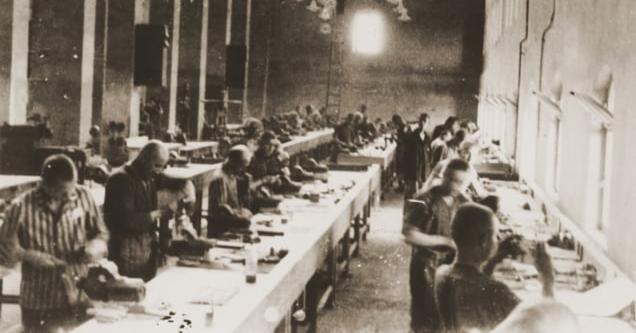Germany’s Nazi era was one of the darkest chapters in human history. Fortunately for mankind, Hitler’s “Thousand Year Reich” lasted only twelve years before getting stomped into the dirt. Still, Germany was one of the world’s leading economies, which meant that many companies – some of them still thriving today – were more than happy to do business with the Nazis.
Following are ten famous companies and their ties to Nazi Germany.
Hugo Boss Was an Active Nazi Who Produced Uniforms For the Brown Shirts, SS, and Hitler Youth
In 2013, comedian Russell Brand was kicked out of a GQ magazine’s Men of the Year Awards shindig, after cracking jokes about the event’s sponsor, Hugo Boss, and its Nazi ties. As Brand put it: “If anyone knows a bit about history and fashion, you know it was Hugo Boss, who made uniforms for the Nazis. …But they looked fu*king fantastic, let’s face it, while they were killing people on the basis of their religion and sexuality“. Understandably, Hugo Boss’ executives were not thrilled that all they got for the £250,000 they spent sponsoring the event was another dose of bad publicity about their company’s Nazi past. Whether Russell Brand’s humor was in good taste or bad, he was not wrong about the fashion designer’s Nazi ties.
Today, Hugo Boss is a global luxury fashion brand, famous for its flashy ties and classic suits, with about 1100 company-owned stores worldwide as of 2016. There was even a time when it seemed that no yuppie was cool unless his wardrobe contained Hugo Boss shirts, suits, socks, sunglasses, cologne, and man-thongs. Less cool was the history of the company’s founder, fashion designer Hugo Ferdinand Boss (1885 – 1948). He was an enthusiastic Nazi who devoted his talents to making Hitler’s goons look as snazzy as possible.
Boss founded a textile factory as a family-run business in 1923, and one of his early big contracts was to supply uniforms to the Nazi party’s SA storm troopers, or Brown Shirts. He eventually joined the party, and when the Nazis took power in 1933, Boss, as an active party member and enthusiastic supporter of its policies, was on the inside track when the new regime began awarding clothing contracts. Before long, Boss’ company was producing, in addition to the Brown Shirts’ uniforms, the black outfits of the SS, and the black-and-brown uniforms of the Hitler Youth.

Production continued and expanded during World War II. By then, Hugo Boss was outfitting the SS, SA, Hitler Youth, German rail workers, postal employees, as well as the German army, navy, and air force. As the conflict raged, Hugo Boss made use of hundreds of slave workers in his factory, mostly from Poland and France, to meet increased wartime production demands.
The slave laborers’ working conditions were dreadful. They were insufficiently fed, received inadequate medical care, and were made to live in unsanitary barracks infested with lice and fleas. During air raids, they were not allowed into shelters but had to remain in the factory. Those who attempted to flee were sent to even more dreadful places if captured, such as Auschwitz.
After the war, during the Denazification process, Hugo Boss was heavily fined, stripped of his voting rights, and prohibited from running a business. He appealed and succeeded in reducing the penalties, but the business ban remained. So he was forced to transfer ownership and management of the company to his son-in-law. In the years since, Hugo Boss has, understandably, not been keen on celebrating its founder or discussing its prewar history. In 1999, the company finally agreed to contribute to a fund to compensate its former slave workers.

